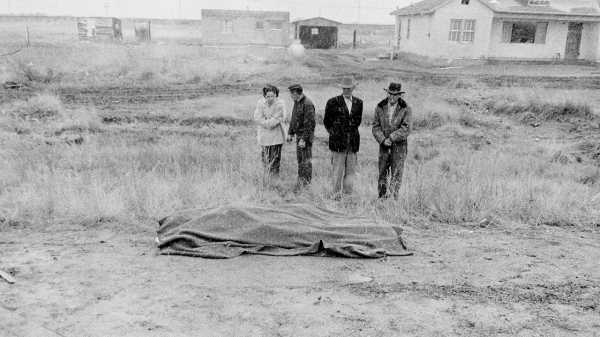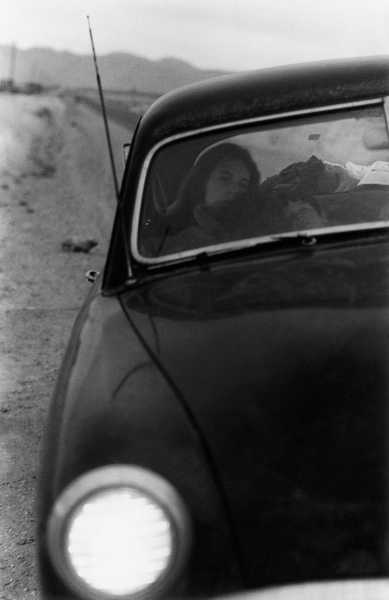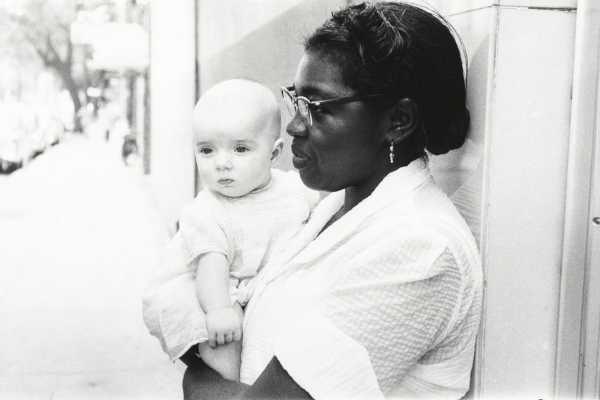
In 1955, Robert Frank left New York in a secondhand Ford Business Coupe to begin making the photographs that became “The Americans,” one of the twentieth century’s most significant works of photography. It is, the filmmaker Ken Burns said recently, “the great American road-trip book.” Frank had grown up in Switzerland, arriving by boat in New York in 1947. When he set out on his travels, he “had no idea,” he said later, where he would find what he was looking for.
Part of what makes “The Americans” potent is the mysterious way that it creates, in eighty-three photographs, the illusion of a representative work, an entire country in pictures. Not everyone was pleased about that. Frank was a ferocious enemy of sentimentality, and the America that he encountered was more troubled than he’d envisaged. Much of the contemporary reaction to his pictures portrayed them as the work of a mean-spirited foreigner out to smear the country that had taken him in. In time, the currents of complication that Frank described became his book’s virtue.
Nearly seventy years later, I wanted to get closer to “The Americans.” If it really was an enduring masterpiece, perhaps through it I would achieve insight into this now cleaving country. So, this summer, I decided to drive across America myself. Before Frank’s death, in 2019, I asked him his advice for travelling cross-country, and he said, “Drive the southern road. More people are outside.” Following Frank’s routes in my Volkswagen, I planned to walk the ground where some of my favorite pictures were made, and engage with whomever I met there. Many of the details in the images were of their time: jukeboxes, enormous Detroit-made, tail-finned sedans, and whites-only rest rooms. But, to me, the photographs felt eternally fresh and affecting, and I wondered how other Americans would see them.
When Frank travelled, he had paper maps, Leica cameras, and tips from his friend Walker Evans about locations in the Carolinas. Frank liked to encounter people, photograph them unseen, click, and move on. “I was just looking at them and leaving it at that,” he told me. “To talk to them would have made it a different book.” For company, he had the car radio, a bottle of French brandy, and occasional hitchhikers. Only in Houston did his wife and his two children—his daughter in diapers—join him for the drive across the plains and the desert to Los Angeles. In one of the book’s better-known images, the family huddles in the Ford, by the side of the road on U.S. Route 90, en route to Del Rio, Texas.
Frank once told me that I was the worst photographer in history. I didn’t disagree. So, when I departed Connecticut on a July Sunday, in the back seat was my eleven-year-old son, Ozzie, holding an iPhone to work the G.P.S., play podcasts, and take photographs. One of Frank’s photographer friends, Tod Papageorge, had advised Ozzie on how to achieve “the look of Robert’s pictures.” Papageorge explained that “the fifty-millimetre lens is comparable to the width and focus of iPhone Portrait mode. It really matches.”
As we descended the Eastern Seaboard, complicating our course was Frank’s propensity for misidentifying his own photographs. It was difficult to find the courthouse square that he supposedly photographed in Elizabethville, North Carolina, because there is no such town. Frank had a sly sense of humor, and he would say things like “It’s the misinformation that’s important.” He also understood that his gift was for revealing emotional truths, not precise geography. “I think people like the book because it shows what people think about but don’t discuss,” he said. “It shows what’s on the edge of their mind.” Sure enough, when we showed “The Americans” to other people, they would look up from a picture and begin to talk about their private selves.
One of Frank’s subjects was the emotional undercurrent of the Jim Crow South. On a sidewalk in Charleston, South Carolina, Frank photographed a Black nanny leaning against a building, holding a porcelain-white, doll-like baby. This was the first of several pictures from the book inhabited by both Blacks and whites, images that are uncomfortable, even painful. In downtown Charleston, we looked at the photograph with Black and white women in business clothing, who said that they thought the nanny was making the best of a humiliating existence. Then we met a Black woman named Gigi, who grew up sleeping seven to a bed, foraging in supermarket dumpsters, picking field beans. She’d since spent forty years employed caring for white children. “I see myself,” she said, looking at the image. “I see me and I do see love. The way she’s holding it—that’s who I am. She’s doing what she wants to do. That’s how I felt. Jesus, yeah.”

“U.S. 90, en Route to Del Rio, Texas” (1955)
At the Memphis railroad station, in the men’s room, Frank watched a white man get his shoes shined by a bent Black man standing so close to a wall of urinals that you can almost smell them. Today, few passenger trains run through Memphis, and most of the station has been converted into a luxury hotel, where we met a Black plumber, who said of the shoe-shiner, “That was his spot to work. But he couldn’t use the rest room. Always separate. Black maids working in the house. They could take care of the baby when it was a baby. Then the baby would come of age, and it was ‘Now that I’m not a child, all you can do for me is shine my shoes in the rest room.’ ” These days, he went on, Memphis had a “lot of shooting. That didn’t happen when people all had jobs. Working people moved away and poverty took over.” Years ago, the plumber said, one of his sisters took her dog outside at night—“he had to use the rest room”—and somebody shot his sister in the face. “Nobody knows why. My wife and I stayed with her boys for a while.”
From Memphis, we drove past Mississippi Delta farms, where center-pivot irrigators watered cotton, rice, and soybean fields through monsoon-like summer rains. Frank was briefly held in a small-town Arkansas jail, for being a stranger with New York license plates, several cameras, and a foreign accent. We didn’t stand out that much, but a surprising number of people back East had thought that our Volkswagen with Connecticut plates might attract problems in places like rural Texas.
There’s evidence in the geographical order of the photographs in Frank’s contact sheets, and in signage captured in some of the outtakes, that the photograph of his family on the way to Del Rio wasn’t taken on Route 90, or even in Texas, but more than a thousand miles away, in Nevada. Outside Geno’s Automotive, on Route 90 in Kingsbury, Texas, we met Weldon, a truck driver who regularly drives the length of the highway. He examined the picture and suggested that Frank could have taken the photograph in southwest Texas, between Uvalde and Brackettville. “John Wayne filmed movies out there,” he said. “Shrubby, desolate desert. You get hills once you’re on the other side of Hondo.” The mention of Wayne and Uvalde, where there had been a recent school shooting, led to a discussion of gun control. Weldon is “an avid gun collector,” he said, and had been shooting since childhood. I had not, and I was soon proposing that Weldon shouldn’t trust me to own a firearm, unless I proved that I wasn’t a danger to others by earning a license—same as with a car. He said, actually, that he might agree, and soon he was telling us about his difficult childhood in Texas, where he was reared by a father with a drinking problem. Then he offered to take photographs for us of the exact spot he had in mind for Frank’s photograph. Which he later did. They were pretty convincing.
This was a common experience. People greeted us with slight initial skepticism, then we’d show them “their” page of “The Americans,” and they were transformed. The next day, on a twelve-hour drive to Santa Fe, there was another monsoon rain, water so dense it became opaque. We pulled onto the narrow shoulder and tried not to think about the pictures of roadside crosses and covered corpses in “The Americans.” The storm passed, and in the cleansed, vivid light Ozzie looked out the back window and saw the endless retreat of New Mexico road and sky that Frank had photographed on Route 285, with a single car tiny on the horizon. “I had a positive feeling driving in this country,” Frank once told me. “I thought, It’s a generous country—it can help people.”
Heading west toward the California desert, we encountered heat over a hundred and ten degrees; the bubble gum that Ozzie had recently cajoled from me melted on the car seat. In Los Angeles, with Sally Stein, a photographic historian, and Doug Suisman, an urban designer who often deploys historical research in his work, we visited the downtown blocks where Frank had photographed what he called a statue of St. Francis, a gas station and city hall looming behind, along with dozens of parked cars. Frank had liked that St. Francis appeared to be “blessing the gas station.” But, Suisman said, “That is not City Hall. It’s the L.A. County Hall of Justice. It’s not St. Francis. It’s a monument to Junípero Serra. They didn’t call him Robert Facts!” We were standing where the founding Spanish settlement of California had been. A homeless man named Harvey said that the area later became “the original encampment for homeless people.” Referencing “The Grapes of Wrath,” Harvey said, “It went from people arriving, seeking opportunity, to now it’s people who’ve lost their opportunity, lost jobs, houses. There’s nothing for them.” Of Frank’s picture, he insisted, “I can tell you that’s in Burbank, because that gas station belonged to my uncle. That’s my uncle’s Chevrolet. I recognize it. A fifty-something Bel Air.” Suisman found moving “his determination to make reality fit his family memory.” Stein said, “The desire to reconnect with his past is so powerful it made him adamant. It shows the precarity of a picture, but also of many lives.”
We went north, then made the right turn back east. Californians had once been resistant to migrants coming from elsewhere. Now, as we drove through Nevada and Idaho, we kept encountering local people who were indignant about how the lure of cheaper housing and cheaper land meant, as a teen-age girl in Blackfoot, Idaho, said, “Too many Californians moving in.” In Blackfoot, Frank had picked up (and photographed) a pair of hitchhikers who wanted to leave. Now the teen-ager said that she felt so crowded by Californians that she was going to move to Montana as soon as she came of age.
Big workplaces interested Frank. He photographed factories and refineries, but in the former boomtown of Butte, Montana, where there are streets named Aluminum, Mercury, and Platinum, Frank was denied permission to visit the closed Anaconda mine. Taken from between the fluttering curtains framing his hotel window, his picture of Butte captured the cost of opportunity, the despoiling of a beautiful place. “It’s one of my favorite pictures,” he told me. “America is a tough country outside.” From the same hotel window, Ozzie and I could see that much of the neighborhood had been razed, and the underground mine was now an open pit. A smelter’s granddaughter named Sandra told us, “When Robert Frank was here, they kind of recognized the environmental devastation, but it was part of so many people’s lives they kind of let it happen. The company built parks and roads, and there was a lot of money for the community.” These days, she said, there were few mining jobs left, the hilltop tailings pond was a weird Gatorade blue, and there was cancer in every family she knew.
Perhaps the country’s most notable boom-bust city is Detroit. Frank made several pictures there, none better than one of an exhilarated Black boy standing in the back of a packed convertible on Belle Isle, an Olmsted-designed park in the Detroit River. Nancy Barr, the photography curator at Detroit Institute of Arts, remembered that, when the museum displayed the photograph, people gathered around it declaring, “This is me as a kid.”

“Charleston, South Carolina” (1955)
On Belle Isle, we encountered a chef named Byron, the owner of a gleaming Chrysler 300, who said that the photograph “takes me back to when I was a child. I lost my father when I was fifteen. He had a heart attack. He worked at Chrysler. Auto industry, like everyone else back then.” Byron wore a photograph of his father attached to a necklace. The boy sees something, Byron thought. “I wish I knew what it was,” he said. Then he did. “They’re seeing the beach for the first time! When I saw the beach for the first time, I went straight out. My brother said, ‘Boy, you don’t know how to swim!’ I said, ‘I do!’ ” ♦
Sourse: newyorker.com






